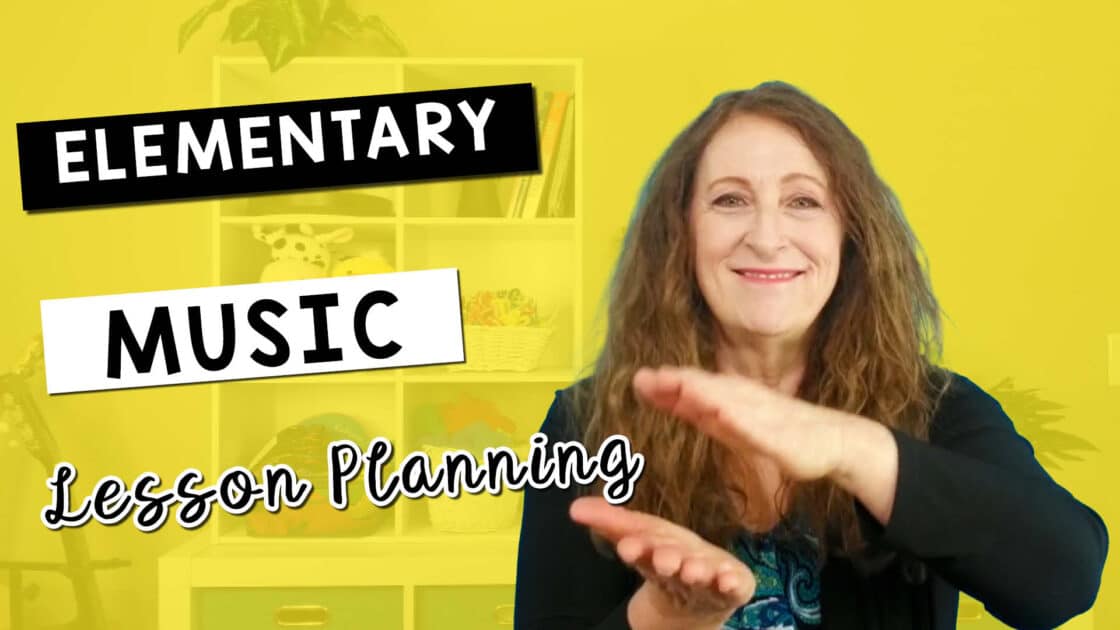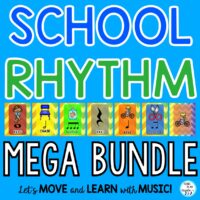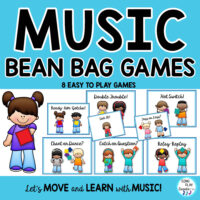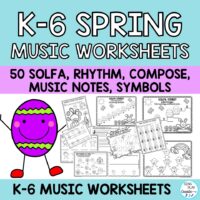


I’m sharing how to take one song and create an entire 8-week unit of music lesson activities. This may seem like a daunting task, but you can do it for one grade at a time and learn as you go.
Creating a music lesson unit using one song is one way for you to organize your lesson plans.
It’s fun to teach a lot of different songs, but this method will help you streamline your lesson activities.
And it will give you time to go in-depth with your students in learning music concepts.
You’ll be establishing your curriculum based on learning music skills instead of doing random activities.
It’s something to consider if you are a new music teacher.
Just think, you’ll have 8 weeks of activities planned for each grade level using only one song.
You’ll take one song and develop a complete music lesson unit. These lesson outlines will be the meat of your lessons.
The reason this method of planning is so helpful is that you now only have 5-6 songs to teach over an entire quarter.
And all the activities for each grade are going to be very similar in that they’ll use the same music props, instruments and classroom organization. This will help you with your time management too!
Amazingly, all the lessons can be structured to follow this plan from grades K-6.
You’ll adapt the activities for each grade level.
Over the course of the unit, you’ll want to cover goals for MELODY, RHYTHM, DYNAMICS, MOVEMENT, PLAYING INSTRUMENTS, SINGING, COMPOSING, and IMPROVISATION.
At the end of the unit, everyone will have learned these basic music concepts.
You’ll want to choose a song that can teach music concepts and has a movement or game component. An example would be “Doggie, Doggie, Where’s your bone?”
You may want to use literature, listening, play alongs, worksheets and other activities to compliment the learning goals of each lesson.
You can also use thematic activities like a Halloween Freeze Dance at the end of class.
Sing Play Create offers many of these types of activities like rhythm play alongs, scarf movement, thematic lessons, and activities as well as thematic worksheet packets.
Of course, you can also use YouTube and the Freebies from the Sing Play Create Free Resource Library too.

Subscribe here to get access to over 75 Freebies.
If you have sets of flashcards or manipulatives like popsicle sticks, you’ll be able to use those for additional activities.
You can read this blog post about rhythm activities. “FIVE EASY ELEMENTARY MUSIC RHYTHM ACTIVITIES”
If you are thinking that each of the activities won’t take up the entire class time- you are right! It’s important to review and practice each new skill as you work through the unit.
This strategy will enable you to assess student ability too.
Another thing to consider is using different types of teaching and learning strategies as you review concepts.
For example, you may introduce the solfege using a cute doggie puppet. The next time you’ll use the presentation and have students follow along. In the third class, you’ll have them sing and sign without your help.
When you are lesson planning, you can really focus on the music skills you want students to learn.
Here’s one way to create a music lesson unit.
A complete unit looks like this:
LEARN THE SONG/PLAY THE BEAT/SING THE SOLFEGE/MELODY/LYRICS
LEARN THE MOVEMENT TO THE SONG, GAME OR ACTIONS
SING AND PLAY THE GAME OR DANCE-LEARN DYNAMICS
IMPLEMENT CLASSROOM INSTRUMENTS-TEACHER LED
CREATE OSTINATO & PLAY TOGETHER-EXPERIMENT WITH IMPROVISATION
PERFORM AS A CLASS -MELODY, RHYTHM, DYNAMICS, MOVEMENT, PERFORM
DIVIDE THE CLASS INTO GROUPS AND PRACTICE
PERFORM IN SMALL GROUPS
During each lesson you’ll do some kind of review or practice of the previous lesson.
In lesson 1 you’ll be teaching the beat and the melody (depending on your methodology)
But that isn’t going to take the entire lesson time.
You’ll want to include supplemental activities like reading a book that coordinates with the song, or playing the beat in a body percussion activity, and/or solfege sight singing practice.
Lesson 2 – Include a review of beat and melody and then teach the game or actions, and movement to the song. This may take the entire class time. If not, you can use a rhythm play-along that supports the rhythms of the song, or a rhythm flashcard play-along. Since the students have been moving, then a sitting-down activity will work well.
Lesson 3 helps the students learn dynamics. You can do a scarf activity to teach fast and slow. Use a scarf video like this one:
Talk about the fast and slow actions.
Sing the song fast and slow and have the students use scarves to show the tempo.
Put the scarves away and teach them when you want them to sing loud and soft in the song. Practice.
Next have them sing and play the game using showing the dynamics.
Lesson 4 includes playing instruments. You may want to do a warm-up first. Use a play-along or some music and have students play beats or rhythms to the music. This will vary for each grade level. For Kindergarten, students will play a steady-beat drum and sing. In 4th grade, students may be able to read the parts on the sheet music and play along as they sing. After playing instruments, students can play the game.
Lesson 5 includes playing an ostinato and improvising. This will vary for each grade level. Kindergarten may experiment with different instruments playing the beat. What does it sound like if we play a maraca? A cymbal? A drum? This would be a great way to introduce the instruments. In the upper grades, students could practice parts and then be challenged to create or play an ostinato as the class sings. If there’s time, play the game.
Lesson 6 includes performing as a class -melody, rhythm, dynamics, and movement.
This is a culminating review of the skills learned so far. Most likely it will take the entire class. Or, use some of the other supporting activities.
Lesson 7 includes practicing in small groups and preparing for performance. Divide the class into groups and practice parts. In grades K-2 you’ll need to adapt this activity. You may want to review all of the supporting activities and have students sing and play the game. For example:
Sing the Song
Scarf Movement
Play Instruments
Play the Game
Read a Story
Lesson 8 – Have the students perform in small groups. Repeat these activities for the younger grades. Give students opportunities to perform as desired.
Creating a unit of learning from one song is a great way to help your students really get good at music making.
From here they can learn improvisation and dive into more songs.








I’m hoping this blog post helps you with your elementary music lesson planning this year.
It’s rewarding to create a music lesson unit for your students and see their musicianship grow!

Please share this post!


Hi there! I’m Sandra, one of the authors behind Sing Play Create. My goal is to provide teachers with interactive resources and activities to improve the effectiveness of their teaching and enhance student learning.

© 2022 Sing Play Create. All Rights Reserved.